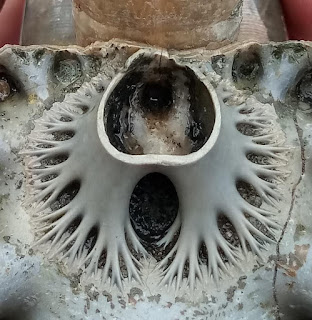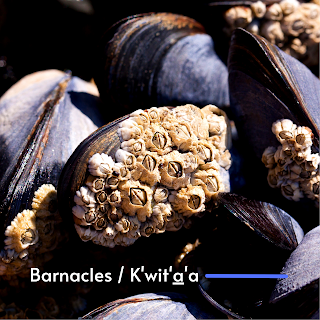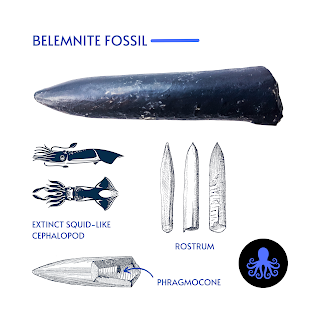 |
| Hoplites (Hoplites) bennettiana (Sowerby, 1826) |
The species name is a homage to Etheldred Benett, an early English geologist often credited with being the first female geologist — a fossil collector par excellence.
She was also credited with being a man — the Natural History Society of Moscow awarding her membership as Master Etheldredus Benett in 1836. The confusion over her name — it did sound masculine — came again with the bestowing of a Doctorate of Civil Law from Tsar Nicholas I.
The Tsar had read Sowerby's Mineral Conchology, a major fossil reference work that contained the second-highest number of contributed fossils of the day, many of the best quality available at the time. Forty-one of those specimens were credited to Benett. Between her name and this wonderous contribution to a growing science, the Russian Tsar awarded the Doctorate to what he believed was a young male scientist on the rise. He believed in education, founding Kyiv University in 1834, just not for women. He was an autocratic military man frozen in time — the thought that this work could have been done by a female unthinkable. Doubly charming is that the honour from the University of St Petersburg was granted at a time when women were not allowed to attend St. Pete's or any higher institutions. That privilege arrived in 1878, twenty years after Nicholas I's death.
Benett took these honours (and social blunders) with grace. She devoted her life to collecting and studying fossils from the southwest of England, amassing an impressive personal collection she openly shared with geologist friends, colleagues and visitors to her home. Her speciality was fossils from the Middle Cretaceous, Upper Greensand in the Vale of Wardour — a valley in the county of Wiltshire near the River Nadder.
Etheldred Benett was born on 22 July 1775 at Pyt House, Tisbury, Wiltshire, the eldest daughter of the local squire Thomas Benett.
Etheldred's interest was cultivated by the botanist Aylmer Bourke Lambert (1761-1842), a founding member of the Linnean Society. Benett's brother had married Lucy Lambert, Aylmer's half-sister. Aylmer was a Fellow of the Royal Society and the Society of the Arts. He was also an avid fossil collector and member of the Geological Society of London. The two met and got on famously.
Aylmer kindled an interest in natural history in both of Benett's daughters. Etheldred had a great fondness for geology, stratigraphy and all things paleo, whilst her sister concentrated on botany. Etheldred had a distinct advantage over her near contemporary, the working-class Mary Anning (1799-1847), in that Benett was a woman of independent wealth who never married — and didn't need to — who could pursue the acquisition and study of fossils for her own interest.
While Anning was the marine reptile darling of the age, she was also greatly hindered by her finances. "She sells, seashells by the seashore..." while chanted in a playful spirit today, was not meant kindly at the time.
Aylmer's encouragement emboldened Etheldred to go into the field to collect for herself — and collect she did. Profusely.
Benett’s contribution to the early history of Wiltshire geology is significant. She corresponded extensively with the coterie of gentlemen scientists of the day — Gideon Mantell, William Buckland, James Sowerby, George Bellas Greenough and, Samuel Woodward. She also consorted with the lay folk and had an ongoing correspondence with William Smith, whose stratigraphy work had made a favourable impression on her brother-in-law, Aylmer.
Her collections and collaboration with geologists of the day were instrumental in helping to form the field of geology as a science. One colleague and friend, Gideon Mantell, British physician, geologist and palaeontologist, who discovered four of the five genera of dinosaurs and Iguanadon, was so inspired by Benett's work he named this Cretaceous ammonite after her — Hoplites bennettiana.
Benett's fossil assemblage was a valuable resource for her contemporaries and remains so today. It contains thousands of Jurassic and Cretaceous fossil specimens from the Wiltshire area and the Dorset Coast, including a myriad of first recorded finds. The scientific name of every taxon is usually based on one particular specimen, or in some cases multiple specimens. Many of the specimens she collected serve as the Type Specimen for new species.
 |
| Fossil Sponge, Polypothecia quadriloba, Warminster, Wiltshire |
To ensure the knowledge was shared in a timely fashion, she finally wrote them up and published them herself. You can read her findings in her publication, ‘A Catalogue of Organic Remains of the County of Wiltshire’ (1831), where she shares observations on the fossil sponge specimens and other invert goodies from the outcrops west of town.
She shared her ideas freely and donated many specimens to local museums. It was through her exchange of observations, new ideas and open sharing of fossils with Gideon Mantell and others that we gained a clearer understanding of the Lower Cretaceous sedimentary rocks of Southern England.
In many ways, Mantell was drawn to Benett as his ideas went against majority opinion. At a time when marine reptiles were dominating scientific discoveries and discussions, he pushed the view that dinosaurs were terrestrial, not amphibious, and sometimes bipedal. Mantell's life's work established the now-familiar idea that the Age of Reptiles preceded the Age of Mammals. Mantell kept a journal from 1819-1852, that remained unpublished until 1940 when E. Cecil Curwen published an abridged version. (Oxford University Press 1940). John A. Cooper, Royal Pavilion and Museums, Brighton and Hove, published the work in its entirety in 2010.
I was elated to get a copy, both to untangle the history of the time and to better learn about the relationship between Mantell and Benett. So much of our geologic past has been revealed since Mantell's first entry two hundred years ago. The first encounter we share with the two of them is a short note from March 8, 1819. "This morning I received a letter from Miss Bennett of Norton House near Warminster Wilts, informing me of her having sent a packet of fossils for me, to the Waggon Office..." The diary records his life and the social interactions of the small connected community of the scientific social elite — pure delight.
Though a woman in a newly evolving field, her work, dedication and ideas were recognized and appreciated by her colleagues. Gideon Mantell described her as, "a lady of great talent and indefatigable research," whilst the Sowerbys noted her, "labours in the pursuit of geological information have been as useful as they have been incessant."
Benett produced the first measured sections of the Upper Chicksgrove quarry near Tisbury in 1819, published and shared with local colleagues as, "the measure of different beds of stone in Chicksgrove Quarry in the Parish of Tisbury.” The stratigraphic section was later published by naturalist James Sowerby without her knowledge. Her research contradicted many of Sowerby’s conclusions.
She wrote and privately published a monograph in 1831, containing many of her drawings and sketches of molluscs and sponges. Her work included sketches of fossil Alcyonia (1816) from the Green Sand Formation at Warminster Common and the immediate vicinity of Warminster in Wiltshire.
 |
| Echinoids and Bivalves. Collection of Etheldred Benett (1775-1845) |
If you'd like to read a lovely tale on William's work, check out the Map that Changed the World: William Smith and the Birth of Modern Geology by Simon Winchester. It narrates the intellectual context of the time, the development of Smith's ideas and how they contributed to the theory of evolution and more generally to a dawning realization of the true age of the earth.
The book describes the social, economic or industrial context for Smith's insights and work, such as the importance of coal mining and the transport of coal by means of canals, both of which were a stimulus to the study of geology and the means whereby Smith supported his research. Benett debated many of the ideas Smith put forward. She was luckier than Smith financially, coming from a wealthy family, a financial perk that allowed her the freedom to add fossils to her curiosity cabinet at will.
Most of her impressive collection was assumed lost in the early 20th century. It was later found and purchased by an American, Thomas Bellerby Wilson, who donated it to the Academy of Natural Sciences of Philadelphia. Bits of her collection made their way into British museums. Leeds City Museum, the British Museum in London, Bristol Museum and the University of St. Petersburg all house her specimens. These collections contain many of the first fossils found of their kind — some with the soft tissues preserved. When Benett died in 1845, it was Mantell who penned her obituary for the London Geological Journal.
 |
| Etheldred Benett (1776-1845) |
Her renown lives on through her collections, her collaborations and through the beautiful 110 million-year-old ammonite you see here, Hoplites bennettiana. The lovely example you see here is in the collection of the deeply awesome Christophe Marot.
Spamer, Earle E.; Bogan, Arthur E.; Torrens, Hugh S. (1989). "Recovery of the Etheldred Benett Collection of fossils mostly from Jurassic-Cretaceous strata of Wiltshire, England, analysis of the taxonomic nomenclature of Benett (1831), and notes and figures of type specimens contained in the collection". Proceedings of the Academy of Natural Sciences of Philadelphia. 141. pp. 115–180. JSTOR 4064955.
Torrens, H. S.; Benamy, Elana; Daeschler, E.; Spamer, E.; Bogan, A. (2000). "Etheldred Benett of Wiltshire, England, the First Lady Geologist: Her Fossil Collection in the Academy of Natural Sciences of Philadelphia, and the Rediscovery of "Lost" Specimens of Jurassic Trigoniidae (Mollusca: Bivalvia) with Their Soft Anatomy Preserved.". Proceedings of the Academy of Natural Sciences of Philadelphia. 150. pp. 59–123. JSTOR 4064955.
Photo credit: Fossils from Wiltshire. In the foreground are three examples of the echinoid, Cidaris crenularis, from Calne, a town in Wiltshire, southwestern England, with bivalves behind. Caroline Lam, Archivist at the Geological Society, London, UK. http://britgeodata.blogspot.com/2016/03/etheldred-benett-first-female-geologist_30.html
Photo credit: Fossil sponges Polypothecia quadriloba, from Warminster, Wiltshire. The genus labels are Benett’s, as is the handwriting indicating the species. The small number, 20812, is the Society’s original accession label from which we can tell that the specimen was received in April 1824. The tablet onto which the fossils were glued is from the Society’s old Museum.
https://www.strangescience.net/ebenett.htm








.png)

















